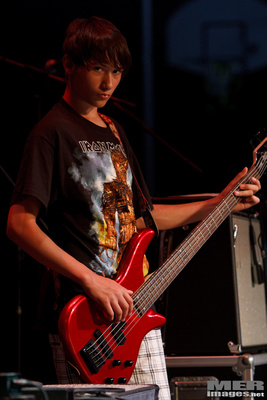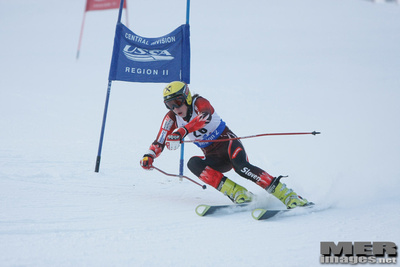I’ve always been fascinated with sunsets and have tried on many occasions to capture them in photos. Anyone who has ever tried doing so I think will agree that it can be quite a challenge.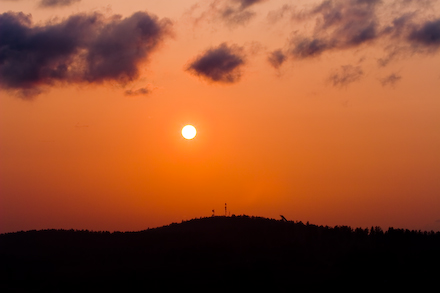 There are a number of things working against a photographer trying to capture a sunset. First of all there is the extreme dynamic range. The sun is a lot brighter than the surroundings and the camera can only capture about 4 stops of light. The sun passing through the edge of our atmosphere greatly reduces its intensity, but it is still a lot brighter as compared to the surroundings.The other problem is lens flare (see my first image for an example of some mild lens flare). This is simply one of those problems we just have to accept when using a digital camera. The problem is that the sensor is reflective so when a bright light source hits it straight on it reflects back out the lens. And because a lens is comprised of a number of glass elements there is a pretty good possibility some of the light reflected off the sensor gets reflected back again which shows up as lens flare. Some lenses have less flare than others and sometimes you can adjust the aim a bit to reduce or possibly eliminate it. If you have a filter on the front of the lens remove it when shooting sunsets to prevent the filter from introducing even more reflections. By the way the same problem exists when shooting the moon since it is actually very bright.To combat the extreme dynamic range I have found that I need to reduce the exposure by 1 or 2 stops under what the camera thinks is right. And don’t aim directly at the sun when getting the exposure setting. Instead focus on something darker that is near it. Once you have the exposure locked then recompose and release the shutter. Review the image with the histogram to see if there is any highlight clipping.
There are a number of things working against a photographer trying to capture a sunset. First of all there is the extreme dynamic range. The sun is a lot brighter than the surroundings and the camera can only capture about 4 stops of light. The sun passing through the edge of our atmosphere greatly reduces its intensity, but it is still a lot brighter as compared to the surroundings.The other problem is lens flare (see my first image for an example of some mild lens flare). This is simply one of those problems we just have to accept when using a digital camera. The problem is that the sensor is reflective so when a bright light source hits it straight on it reflects back out the lens. And because a lens is comprised of a number of glass elements there is a pretty good possibility some of the light reflected off the sensor gets reflected back again which shows up as lens flare. Some lenses have less flare than others and sometimes you can adjust the aim a bit to reduce or possibly eliminate it. If you have a filter on the front of the lens remove it when shooting sunsets to prevent the filter from introducing even more reflections. By the way the same problem exists when shooting the moon since it is actually very bright.To combat the extreme dynamic range I have found that I need to reduce the exposure by 1 or 2 stops under what the camera thinks is right. And don’t aim directly at the sun when getting the exposure setting. Instead focus on something darker that is near it. Once you have the exposure locked then recompose and release the shutter. Review the image with the histogram to see if there is any highlight clipping.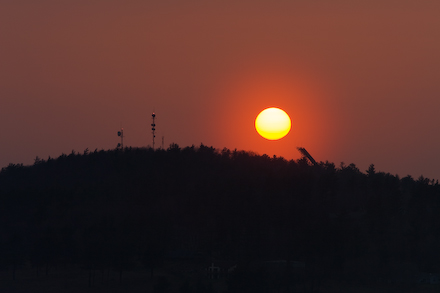 If there is a lot of clipping reduce the exposure another stop and try it again. If you run out of exposure compensation adjustment then stop the lens down more. I usually start with f/16 when shooting sunsets and go smaller as needed to prevent clipping. The trick with all of this is that as the sun gets lower in the sky it has less light so you need to remember to reverse the process as it nears the horizon.The other thing to keep in mind is to not go overboard with under exposing. It may seem like a great way to avoid clipping, but it will introduce noise in the image. You still want to get the exposure as high as you can without excessive clipping of the highlights. I always take multiple shots varying the exposure compensation so I have some alternatives should I find I was being too aggressive one way or the other. You can always set up exposure bracketing to help with this also.
If there is a lot of clipping reduce the exposure another stop and try it again. If you run out of exposure compensation adjustment then stop the lens down more. I usually start with f/16 when shooting sunsets and go smaller as needed to prevent clipping. The trick with all of this is that as the sun gets lower in the sky it has less light so you need to remember to reverse the process as it nears the horizon.The other thing to keep in mind is to not go overboard with under exposing. It may seem like a great way to avoid clipping, but it will introduce noise in the image. You still want to get the exposure as high as you can without excessive clipping of the highlights. I always take multiple shots varying the exposure compensation so I have some alternatives should I find I was being too aggressive one way or the other. You can always set up exposure bracketing to help with this also.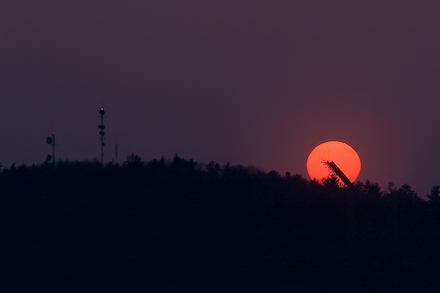 Keep in mind that there will be a point, as the sun nears the horizon, where you will need to reverse the process with exposure compensation and aperture. And depending on how dark it gets you might need to go into mirror lockup mode and remote trigger the shutter. Just be careful to not use too long a shutter because the sun moves rather quickly and will become a blur if you use something longer than 1/30th of a second. Be prepared as this part of the sunset goes by really fast as opposed to the point leading up to it where it feels like it is taking forever.Photographing a sunset is not easy. I respect those who do so well. A lot of it is finding a lens that has little flare and to only photograph it when the suns intensity is low. But if you realize how you can improve your chances you just might get some decent shots.
Keep in mind that there will be a point, as the sun nears the horizon, where you will need to reverse the process with exposure compensation and aperture. And depending on how dark it gets you might need to go into mirror lockup mode and remote trigger the shutter. Just be careful to not use too long a shutter because the sun moves rather quickly and will become a blur if you use something longer than 1/30th of a second. Be prepared as this part of the sunset goes by really fast as opposed to the point leading up to it where it feels like it is taking forever.Photographing a sunset is not easy. I respect those who do so well. A lot of it is finding a lens that has little flare and to only photograph it when the suns intensity is low. But if you realize how you can improve your chances you just might get some decent shots.
Catching a sunset…
- No comments yet.
- No trackbacks yet.
